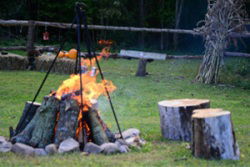
The rule helps protect Indiana’s trees from the 140 known pests and pathogens that currently affect forests, as well as pests we don’t know about yet. Several pests and pathogens are transported through firewood movement.
Under the rule, visitors to state parks, reservoirs, state forests, and state fish & wildlife areas can bring firewood from home—as long as the bark has been removed. Removing the bark minimizes the risk of accidental infestation through firewood movement, because insect larvae live in sapwood under the bark.
Guests may also bring firewood into DNR properties, if it’s:
— Kiln-dried scrap lumber.
— Purchased outside the property and bears either a USDA compliance stamp or a state compliance stamp.
— Purchased from the property campstore or on-site firewood vendor and has a state compliance stamp.
Regardless of where visitors get their firewood, they should burn it all at the campsite before they leave.
In short, the firewood rule means: Buy it with a stamp, bring it debarked, burn it all.
“There are several invasive species causing significant damage to Indiana’s natural resources at this time” said State Entomologist Megan Abraham, who is the director of the DNR Division of Entomology & Plant Pathology. “Emerald Ash Borer, Callery pear, Gypsy moth, Kudzu, Hydrilla, and Purple Loosestrife to name a few.”
“It’s the species that we have not spotted in Indiana that we need help from the public to keep an eye out for,” she added.
The DNR asks members of the public to keep an eye on their local forests and natural resources for signs and symptoms of trees or vegetation dying off for seemingly no reason.
“The DNR would rather come out and inspect an area and find nothing to worry about than find out after the fact that someone had spotted a problem and failed to report it,” Abraham said.
If you see signs of trees in decline with no explanation, call the DNR at (866) NO EXOTIC (866-663-9684) with the date and location. Members of the public may report invasive species to the DNR through the Report IN website at eddmaps.org/indiana/, or by downloading the Great Lakes Early Detection Network (GLEDN) app on a smartphone.
For more about the rule see firewood.dnr.IN.gov.
For more information on all invasive species that could affect Indiana and ways to help stop their spread, see dnr.IN.gov//3123.htm.
To view all DNR news releases, please see dnr.IN.gov.



